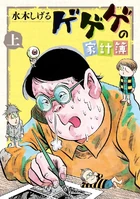It will be finished as soon as possible. We're working as fast as we can, sheesh! |
The Dai-Kaijū (大海獣 Dai-Kaijū, lit. Great Sea Beast) or the Kujira-Gami (鯨神 Whale God) or the Zeuglodon (ゼウグロドン) or the Zeokuronodon (ゼオクロノドン) are either a great kaijū or an ancient whale whose blood is believed to contain the secret to immortality.
About[]
Dai-Kaijū's original concept was in the non-Kitarō story Monster Raban in 1958 in which Godzilla and Raban appeared instead of Dai-Kaijū, it has since become a recurring character in the franchise, appearing in most adaptations.
The actual Dai-Kaijū itself is not as prominent as Kitarō and Ichirō Yamada in their Dai-Kaijū forms.
Iron Dai-Kaijū is the mechanical counterpart of the monster.
Etymology[]
The name Dai-Kaijū (大海獣) is a play on Dai-Kaijū (大怪獣), referring to characters, like Godzilla and Gamera, that are notable in size or might even by standards of giant monsters (Kaijū, 怪獣), while the term Kaijū (海獣) means "marine mammals" in Japanese.
Zeuglodon is a direct interpretation of a synonym of Basilosaurus, and Zeokuronodon is a modified alias of it.
Appearance[]

Illustration of the small individual appeared in Kitarō Kunitori Monogatari

Size comparison to the Tokyo Metropolitan Government Building.
Dai-Kaijū is a gigantic, bipedal, and hairy whale with the head resembling that of baleen whales with baleen-like shaped fangs and unproportionally small tail, and gorilla-like limbs. Dai-Kaijū in the 1985 anime possess claws on their fingers.
In the Hakaba no Kitaro, Dai-Kaijū, both the original individual and transformed Ichirō Yamada were much smaller than in later.
In the Gegege no Kitaro and related franchizes, Dai-Kaijū greatly varies in coloration from brown, ocher, blue, black, and green.
While Dai-Kaijū's actual height is unclear, it can be speculated that total height could be nearly as tall as 200 meters based on the description in the manga noting "six times bigger than whales" and the size comparing to Tokyo Metropolitan Government Building.
In several publications, Dai-Kaijū were noted to weigh more than 20,000 tons.[1]
Kitarō usually regains his left eye as he becomes a Dai-Kaijū except for the 1996 anime.
Another individual appeared in Kitarō Kunitori Monogatari who visited to watch sumo matches is much smaller than other known individuals.
In the 1996 Anime, there is a contradiction between the skeleton of Zeokuronodon in Baruru Island and the recognition of Zeokuronodon by humanity despite the anatomy of Dai-Kaijū completely differs from the Zeokuronodon's skeleton and briefly seen silhouette of the prehistoric cetacean.
Personality[]
Both in Hakaba Kitarō and the GeGeGe no Kitarō series, Dai-Kaijū is depicted to be a docile race, usually remaining calm where they share wetlands with avian and birds are not afraid of the monsters.[2] However they will go into a frenzy when they feel acute pains caused by humans to take blood samples of the monster.
History[]

Ichirō Yamada as Dai-Kaijū reunites with his parents.

Kitarō as Dai-Kaijū fights Iron Dai-Kaijū.
Hakaba no Kitaro[]
In the Hakaba Kitarō, the beast's identity was initially speculated as a Zeuglodon, the ancestor of the modern whale, that became a yōkai indigenous people called Whale God, but humanity doubted the identification. It has been living in the wetlands of New Guinea for millions of years and especially resided within the Lake Rado, usually appearing at night.[3]
Manga[]
The larger Dai-Kaijū appears in the chapter Dai-Kaijū (story).
The smaller individual appears in the Kitarō Kunitori Monogatari
First Anime[]
The Dai-Kaijū appears in the fifth and sixth episodes of the first anime adaptation, Dai-Kaijū (Part 1) and Dai-Kaijū (Part 2).
Third Anime[]
The Dai-Kaijū appears in episodes #67 and #68 of the third anime adaptation, Dai-Kaijū of the Jungle and Dai-Kaijū's Angry Counterattack.
Fourth Anime[]
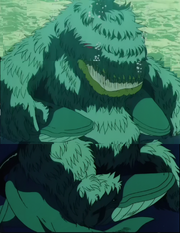
Blue Whales helping Kitarō as Dai-Kaijū.
The Dai-Kaijū appears in the first movie based on the fourth anime adaptation, GeGeGe no Kitarō: Dai-Kaijū.
Zeokuronodon (Dai-Kaijū) is worshiped as a god by both Yōkai (Akamata, Chinpo, Yashi-Otoshi, and Kijimuna) and islanders of Baruru Island. The natural pool in which Zeokuronodon's skeleton is situated, is a scared and irrefutable place for the resident Yōkai. Medama-Oyaji wasn't aware of Dai-Kaijū despite his tremendous amounts of knowledges of supernatural beings around the world.
Chinpo stated that it requires such vast amount of spiritual energy from all over the world to resuscitate Zeokuronodon and so they gave up but instead made Kitarō to drink the spiritual water of the pool to transform him into Dai-Kaijū.
Later, Kitarō forgave Akamata and others because a pod of blue whales, descendants of Zeokuronodon, saved and protected him when he was weaken.
Powers and Abilities[]
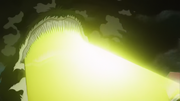
Dai-Kaiju (Kitaro)'s hair beam in the 1996 anime.
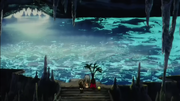
The scared pool of Baruru Island filled with the Water of Life.

Dai-Kaiju (Kitaro) performing his physical prowess in the 1985 anime.
While most of the abilities by the original Dai-Kaiju are unclear, Kitarō as Dai-Kaiju performed variety of abilities even though he lost all of his original spiritual powers, and the iconic hair beam is somewhat akin to Kitarō's hair-related abilities.
Immortality: Although the time spans differ on each incarnations, Dai-Kaijū is noted to be physically immortal and can live for at least hundreds of thousands[3] to 300 millions of years.[1]
Transmutation blood: Dai-Kaijū's blood contains supernatural powers to transform other organisms into a new Dai-Kaijū.
- Water of Life: In the 1996 Anime, the water of the scared pool which harbors the skeleton of Zeokuronodon is called the Water of Life (命の水, Inochi no Mizu). The water itself contains powerful spiritual powers and will transform anyone who drinks it into a new Dai-Kaijū.
Hair Beam: While not being performed by the original Dai-Kaijū and the incarnation of Ichirō Yamada, Kitarō as Dai-Kaijū possessed this ability. Kitarō fires beams of light from his mouth which instantly grows hairs on targets including Yōkai and metals. It also bends metals such as cannons on tanks.
Energy Beam: Within GeGeGe no Kitarō: Black Kitarō no Yabō, Dai-Kaijū is capable of firing a destructive energy projectile from its mouth.
Cetacean Physiology: Dai-Kaijū can swim very fast despite their sizes, and can submerge underwater for extended periods of time.
Durability: Kitarō as Dai-Kaijū completely endured a hydrogen-bombing at close range and stand still in the water not to damage Shūichi Yamada and his family hiding within his mouth. Kitarō was heavily damaged as to be extremely exposed to radiation, but he later detoxified all the radiation through urine.
Whirlpool: In the 1968 Anime, Kitarō as Dai-Kaijū caused a massive whirlpool to disrupt military forces.
Black cloud and wind: Both in A Secret Story and Dai-Kaijū, the original Dai-Kaijū caused black clouds and mysterious winds. In the former, the winds were filled with powerful Yōkai energy when the monster made the first appearance, and Nezumi-Otoko realized that Dai-Kaijū may be a Yōkai.[3][4]
Human Speech: Unlike Kitarō, Ichirō Yamada as Dai-Kaijū in A Secret Story can talk human speeches therefore can ask help to others. The original Dai-Kaijū in this episode also made a loud laughter in human speech.[3]
Trivia[]
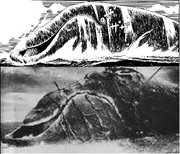
Comparison of Dai-Kaiju in manga and Daiei's Whale God.
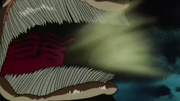
Dai-Kaijū's baleen plates in the 1996 Anime
- Kujira-Gami, an alias of Dai-Kaijū by indigenous people of New Guinea, is presumably based on Daiei's Kujira-Gami in 1962. This is further supported by the close resemblances of both characters in specific scenes, and Dai-Kaijū's appearance to have Balaenidae-like head with strongly-arched jawline, apparent lack of ventral grooves, and thickest build where Daiei's Whale God is a North Pacific Right Whale.
- A number of staff of Daiei's Yōkai and Gamera and Dai-Majin films such as Masaichi Nagata and Tokuzō Tanaka worked for the Whale God. Additionally, music of Kujira-Gami was composed by Akira Ifukube who is known for his works of various monster films including the Dai-Majin franchize, and one of his students is Kaoru Wada.
- Tokuma-Shoten, the copyright holder of the Daiei films until 2003, published a book which includes a scenario of melee fights by Daiei monsters and extraterrestrial races, and Whale God was featured as one of characters to aid Gamera to protect the Earth.[5]
- The 1999 film Gamera 3: Revenge of Iris presumbably planned to insert a reference to the Whale God where Gamera briefly interacts with a cow-calf pair of North Pacific Right Whales nearby the "Gamera's Grave" and the sunken ruin of Atlantis.[6]
- Several scenes in Monster Raban also bear notable similarities with Gamera films, such as Godzilla's initial appearances to that of Gyaos in Gamea vs Gyaos, and humanities' effort to turn Raban back to Ichirō Yamada to that of Gamera's rescue attempt in Gamera the Brave.
- In the 1996 anime, Dai-Kaijū's "teeth" bends when Kitarō roared, indicating that this incarnation of Dai-Kaijū has baleen plates instead of actual teeth unlike in the manga where Kitarō used his fangs to bit Iron Dai-Kaijū.
- Within one of the variations of the recurring episode in the manga, Shigeru Mizuki accidentally drew an anatomically different tail of Dai-Kaijū.
- Unlike canonical versions, Kitarō actually encountered the original Dai-Kaijū in the Pocket Picture Book edition.
- Riku Sanjō revealed on an interview for Otona-Media that he was planning to include more of traditional episodes for 2007 anime and he mentioned that Iron Dai-Kaijū was one of those, indicating he was planning to make a Dai-Kaijū episode.[citation needed]
References[]
- ↑ 1.0 1.1 世界の怪獣大百科 ケイブンシャの大百科 勁文社 昭和57年 初版
- ↑ Shigeru Mizuki, Hakaba Kitarō, "Dai-Kaijū Part 1", p.6
- ↑ 3.0 3.1 3.2 3.3 Hakaba Kitarō: A Secret Story
- ↑ Shigeru Mizuki, Hakaba Kitarō, "Dai-Kaijū Part 1", pp.14-15
- ↑ OMEGA遊撃隊, 1995, 強いぞ!ガメラ, Tokuma Shoten, ISBN-10 : 4198602573, ISBN-13 : 978-4198602574
- ↑ ASCII MEDIA WORKS, February 8th, 2014, Heisei Gamera Perfection , p.264, Kadokawa, Isbn:9784048918817
[]
| Main Characters | Kitarō • Medama-Oyaji • Nezumi-Otoko • Mizuki |
| Secondary Characters | Iwako • Hageyama • Mizuki's Mother • Nashita Kaneno • Neko • Trump Omoi • Beatnik • Mononoke • Ichirō Yamada • Masaichi • Shigeru Mizuki • Kinnosuke Ochiba & his Doctor |
| Threats | Yasha • Dracula IV • Fake Kitarō • Mizugami • London Werewolf • Kaneda & Murata • Johnny in the Mist • Dai-Kaijū • Sennin • Underground Mizuki |
| Obake School | Dr. Gamotsu • Caroline • Adobarana |
| The Other World | Jigoku Ticket Taker • The Guide • The Bird That Takes One Step a Millennium • Walking Plant • Nameless Creature That Extends About 10 Kilometers • Living Oasis |
| Sukiyaki Party | Sunakake-Babaa • Konaki-Jijii • Nurikabe • Hitorima • Kishinbō • Miage-Nyūdō • Sodehiki-Kozō • Tatami-Tataki • Tenka • Tsuchi-Korobi • Tsurube-Otoshi |
| Others | Ghost-like Patient • Medium • Bon Arima • Machamitsu Moriwaki • Hibari Ōzora • Gama-Reijō • Mary • Hayato Ikeda • Fly • Hanao Muraoka • Gosaku • Blood Onsen Kappa • Tompo |

